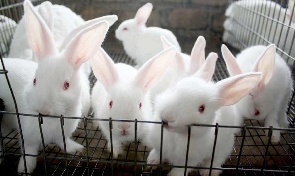 There is growing fear among rabbit farmers over a possible collapse
There is growing fear among rabbit farmers over a possible collapse
There is growing fear among rabbit farmers over a possible collapse of the industry due to rising cost of production.
Currently, farmers say feed alone constitutes about 80 percent of farm’s daily production cost, with the price of 50kilogram of feed having more than doubled from GH¢205 in the second quarter of 2021 to GH¢485 in the first quarter of 2023, representing an increase of 136.6 percent. The situation is further aggravated by biosecurity risk – outbreak of pests and diseases as well as overhead cost – electricity bills and others.
As a result, as many as 70 percent of farms have shut down operations, including that of popular veteran musician Czar, with the few surviving farms only managing to maintain limited rabbit population.
“Due to the situation, I have sold off my rabbits – 3000 of them, for a pittance and shut down the rabbitry. Infrastructure of the once-thriving farm has now become a playground for rodents and food for termites. I barely made a profit going into large-scale production,” said Augustine Osei Bonsu, popularly known by stage name Czar, who is Chief Executive Officer of Dr. Czar Rabbicare.
Once the owner of the biggest rabbit farm in Accra, he spoke to the B&FT from his rabbitry situated at New Legon-Akatamanso in Accra about how production cost alone grinded his rabbit farming business to a halt.
Lamenting on his tough journey as a rabbit producer over the past 6 years, he revealed that as the size of his farm increased, so did production and overhead costs. “As the number of rabbits increased, their feeding cost became a challenge for me because I was spending far more, feeding them, than I was earning, selling them at maturity stage. Somewhere along the line, I boasted a farm size of 3000 rabbits, and had agriculture students from several Ghanaian universities visiting to undertake their research work free of charge.”
He also spent over GH¢200,000 on infrastructure alone.
“I began with 150 rabbits, which may sound a bit over-ambitious; but I did so because of the strong passion I have for anything agriculture-related. In the course of time, my rabbits multiplied greatly, surviving all major pest and disease outbreaks due to the proper farm management systems I had put in place, including biosafety measures,” he said.
Sadly, he said had to sell the entire rabbit population off and shut down the farm, saying: “I realised I was running at a loss due to the huge amount of money that went into feeding them. The situation was further compounded by a slow sales phenomenon of matured rabbits, resulting in extra feeding expenditure.
“I had grouped my 3000 rabbits into 15 separate cages, with each cage housing 200 of them, based on their age, breed as well as size and so on. It may interest you to know that I was spending two bags of layer mash, totalling GH¢360, plus an additional 10 bags of wheat bran, also summing up to GH¢250 to feed just a cage of rabbits for two weeks about two years ago,” he said.
This means that to feed the entire 3000 rabbit population for two weeks, he had to cough up a whopping GH¢9,150 at the time. Meanwhile, the cost of a matured rabbit was hovering around just GH¢100 to GH¢120.
The need to mitigate the effect of the losses he was incurring led Mr. Bonsu into selling grilled and cooked rabbit meat to local Ghanaian pubs, restaurants, hotels and some individuals who know about the health benefits of rabbit meat – white meat with less fat. But this also came with its own challenges as customers took advantage of the market unavailability to dictate price levels.
“This is what I was doing in order to get back some of the money I invested in the rabbits,” he said, adding that he sold each rabbit for a pittance GH¢80 to avert an extra post-maturity feeding cost. “I was fortunate, breaking even after subtracting production and overhead cost.”
Similarly, winner of Adentan Municipal Assembly (AdMA) best backyard rabbit farmer award-2012, Ebenezer Mega, sharing his sentiment, indicated that about 70 percent of rabbit farmers he knows are now out of business owing to the high cost of production, particularly feed. He explained that poultry feed, such as wheat bran, broiler starter and layer mash, which are also fed to rabbits, have become very expensive, making it increasingly impossible for rabbit farmers to buy.
“For instance, the price of layer mash – a source of rabbit protein –shot up from GH¢95 during the third quarter of 2017, to GH¢385 per 50 kilogram bag in the first quarter of 2023. A bag of wheat bran has also seen an increase from GH¢18 in 2017, to GH¢100 per 50 kilogram bag in 2023,” he said.
Aside from imported feed, Mr. Mega lamented that it is sometimes difficult to imagine that feed produced locally, such as broiler starter and wheat bran, can get so expensive to the extent that farmers cannot afford to buy.
“I only have about 60 rabbits now, a huge drop from the 400 rabbits I boasted in 2017 when I emerged as AdMA best backyard rabbit farmer. Feeding cost alone is gradually kicking me out of business,” Mega further bemoaned.
He therefore appealed to the government to invest into the rabbit industry as it is an area with huge economic potential. “Subsidising the cost of rabbit feed, bearing part of overhead cost, fixing poor road networks leading to farms and provision of land for newbies in the rabbit industry are some of the steps that can be taken by the government to keep the industry afloat.”
Watch the latest edition of BizTech and Biz Headlines below:
Watch the latest edition of Business Moments below: